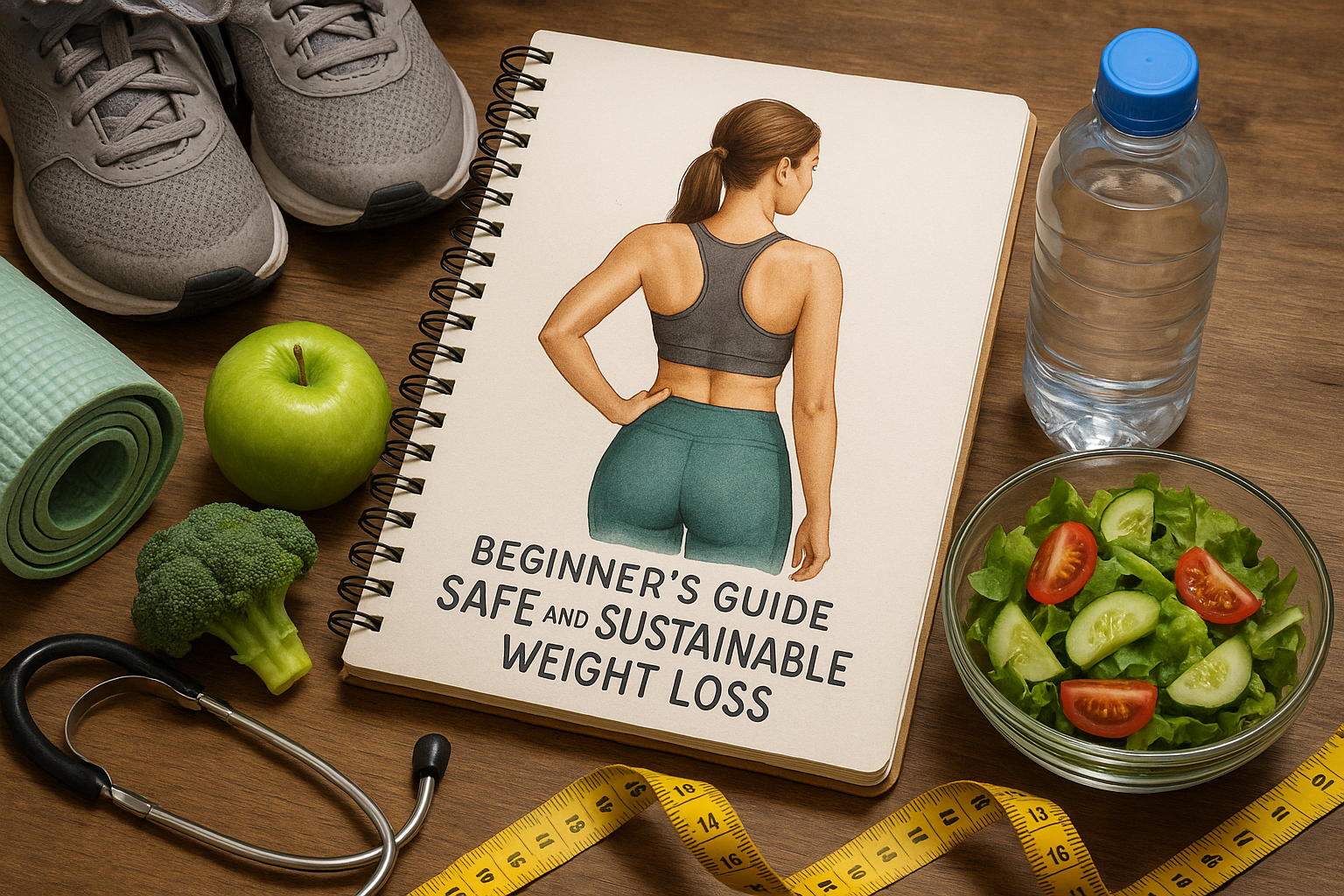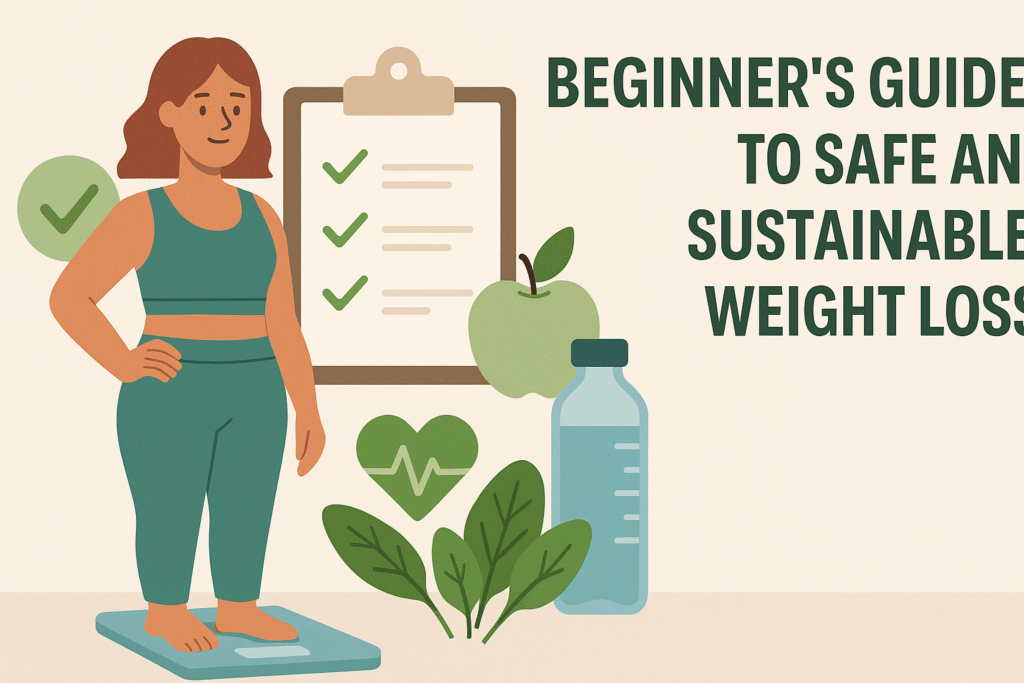Setting a realistic, healthy approach is the best way to lose weight and keep it off. Safe, sustainable weight loss focuses on small, consistent changes to eating, movement, sleep, stress and habits rather than on crash diets or quick fixes. Below are practical, evidence-based steps and tips to help beginners start and maintain progress.
Why safe and slow wins
– Aim for gradual weight loss: about 0.5–1 kg (1–2 lb) per week. Faster loss often means muscle loss, nutrient deficiencies, greater rebound risk and health complications.
– A modest daily calorie deficit (roughly 300–700 kcal/day for many people) produces steady loss while preserving energy and strength. Rough rules: a 500 kcal/day deficit is commonly used and corresponds roughly to ~0.5 kg (1 lb) per week, but individual needs vary.
– Focus on behaviors you can maintain long term. Short-term restrictive plans often fail because they’re unsustainable.
Set realistic, measurable goals
– Make goals specific, measurable and time-framed (SMART). Instead of “lose weight,” try “lose 4–6 kg in 3 months by reducing portion sizes, walking 30 minutes/day and strength-training twice a week.”
– Track progress with multiple measures: how clothes fit, energy levels, strength and fitness improvements, body measurements, and the scale. The scale alone doesn’t tell the whole story.
Nutrition basics
– Prioritize whole foods: vegetables, fruit, lean proteins (poultry, fish, legumes), whole grains, nuts, seeds, and healthy fats (olive oil, avocado). These are nutrient-dense and more filling per calorie than ultra-processed foods.
– Balance macronutrients:
– Protein: aim for a higher-protein approach when losing weight to preserve muscle and increase satiety. A general range is 1.2–2.0 g/kg body weight for active individuals; lower end for sedentary.
– Carbohydrates: choose fiber-rich sources (vegetables, legumes, whole grains) to help fullness and blood sugar control.
– Fats: include healthy fats in moderation—fat is calorie-dense but important for satiety and nutrient absorption.

– Use the plate method: half non-starchy vegetables, one-quarter lean protein, one-quarter whole grains or starchy vegetables; add a small portion of healthy fat.
– Control portions: use smaller plates or measure portions until you develop an intuitive sense of serving sizes.
– Mindful eating: eat slowly, remove distractions, tune into hunger and fullness cues.
Practical meal ideas (simple and flexible)
– Breakfast: Greek yogurt with berries and a sprinkle of nuts; or scrambled eggs with spinach and whole-grain toast.
– Lunch: big salad with mixed greens, roasted vegetables, chickpeas or grilled chicken, olive oil & vinegar.
– Dinner: baked salmon, quinoa, steamed broccoli; or stir-fried tofu with mixed veggies and brown rice.
– Snacks: apple with peanut butter, carrot sticks and hummus, a small handful of almonds, or cottage cheese.
Move regularly — both cardio and strength
– Cardio: aim for at least 150 minutes of moderate-intensity or 75 minutes of vigorous-intensity aerobic activity per week (or a mix). Brisk walking counts and is a great place to start.
– Strength training: include resistance work 2–3 times per week to preserve/build muscle, improve metabolic rate and support long-term weight maintenance. Compound movements (squats, push-ups, rows, lunges) are efficient.
– Increase NEAT (non-exercise activity thermogenesis): take stairs, stand more, walk during phone calls. Small increases in daily movement add up.
– Start slowly and progress: begin with manageable sessions (20–30 minutes) and gradually increase duration or intensity. Prioritize consistency.

Behavioral strategies for adherence
– Plan meals and prep: cooking at home more often helps control ingredients and portions.
– Self-monitoring: food logs, a brief weekly weigh-in, or photo logging can increase awareness and accountability. Don’t obsess over daily fluctuations.
– Problem-solve barriers: anticipate social situations (eat a light snack before events, choose smaller portions) and have go-to options for busy days.
– Build social support: partner with friends, join a class, or engage a coach for accountability.
Sleep, stress and other factors
– Sleep: aim for 7–9 hours per night. Poor sleep increases hunger hormones and cravings.
– Stress management: chronic stress raises cortisol and can promote overeating. Practice stress-reduction techniques (deep breathing, walking, meditation, hobbies).
– Alcohol: reduces inhibition, adds calories and can disrupt sleep. Limit intake if trying to lose weight.
Avoid pitfalls and unsafe practices
– Don’t follow extreme, very-low-calorie diets or diet pills without medical supervision. They can cause nutrient deficiencies, gallstones, muscle loss and metabolic slowdown.
– Beware of “detoxes,” cleanses and fad diets promising rapid results. They may produce short-term loss but are usually unsustainable.
– If you have medical conditions (diabetes, heart disease, thyroid issues), take medications affecting weight, are pregnant or breastfeeding, consult a healthcare provider before starting a weight-loss plan.

Plateaus and troubleshooting
– Plateaus are normal. Reassess portion sizes, activity levels and protein intake. Small, sustainable changes often unstick progress.
– Consider increasing resistance training or adjusting daily calorie intake modestly rather than making drastic cuts.
– If you’ve tried sensible changes for several months without progress, discuss assessment of metabolism, medications or underlying conditions with your clinician.
When to seek professional help
– If you have significant medical conditions, take medications, or have a history of disordered eating, consult a physician, registered dietitian or mental health professional.
– A registered dietitian can create a personalized, safe plan that fits your preferences and medical needs.
Long-term maintenance
– Maintenance is about keeping the habits that work: ongoing physical activity, balanced eating, regular sleep and self-monitoring.
– Expect lifestyle adjustments rather than a “finish line.” Intentional habit changes lead to lasting results.
Final note
Small, consistent changes add up. Prioritize behaviors you enjoy and can stick with—those are the changes that will produce safe, sustainable results. If you’re uncertain where to begin or have health concerns, a primary care provider or registered dietitian can help tailor a plan for your needs.

